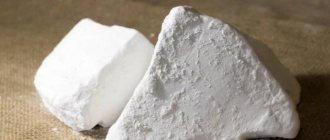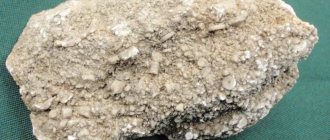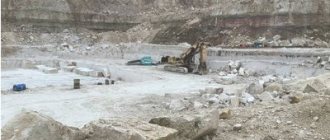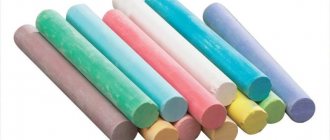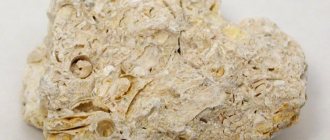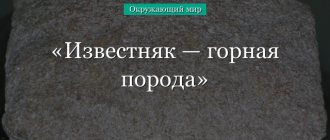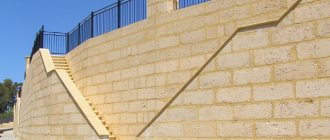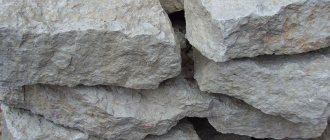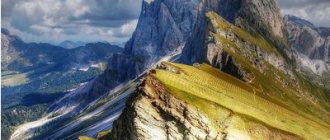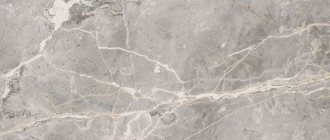4.1
Average rating: 4.1
Total ratings received: 21.
4.1
Average rating: 4.1
Total ratings received: 21.
In people's minds, all rocks are hard, durable, and heavy. However, some of them can be rubbed with your fingers. Chalk is one of these rocks. Its deposits are found everywhere, and the white chalk cliffs are a popular tourist attraction. What chalk is, a description of its properties, where it is used, will be discussed in the article.
What is chalk?
Chalk refers to rocks formed due to the activity of marine organisms. These are calcareous algae and microscopic single-celled foraminiferal creatures that built shells from calcium salt, taking it from sea water.
Rice. 1. Foraminifera.
The origin of chalk explains its composition: foraminifera shells, pieces of calcareous algae, quartz grains, clayey material, and metal compounds are found as admixtures. Large mollusk shells are observed in the rock.
The most active Cretaceous deposits were formed between 66 and 145 million years ago. Geologists called this time the Cretaceous period.
Features of occurrence
About eighty thousand years ago, when, according to historians, the planet was inhabited by all kinds of dinosaurs, millions of shellfish lived in the sea. It was they who laid the foundations for the formation of chalk deposits, which are now widely mined and used by modern people.
The formation of a calcium-containing substance found in the shells and shells of sea creatures occurred due to the presence of dissolved calcium in the water and the physiological characteristics of the mentioned mollusks. When these mollusks ceased to exist, over time, thick layers of chalk calcite deposits appeared at the bottom of salty reservoirs.
Properties of chalk
Chalk is a sedimentary rock consisting of microscopic crystals of calcite. It is considered a type of limestone. Its external signs:
- white, sometimes yellowish;
- hardness is 1, that is, the rock is easily destroyed by hand, the nail leaves a deep mark;
- the rock is fine-grained, after destruction it turns into powder;
- chalk is not resistant to frost and crumbles when defrosted.
For use in industry and agriculture, chalk is divided into two types: natural and chemically produced.
Mineral structure
The physical properties of this fossil mineral depend on the structure of chalk, that is, its internal structure. In particular, the hardness of each piece of chalk directly depends on the presence of silicon in its structure and the percentage of this element. Loose chalk rocks break very easily in your hands and look more like limestone. The structure of such chalk deposits has a density of about eight hundred kilograms per cubic meter. At the same time, the crystalline structure of some limestones reaches 2900 kg/m3.
The porosity of chalk or its looseness also affects the compressibility of this substance. The minimum withstand pressure on chalk is 0.4 MPa, and the maximum is 300 MPa. The structure of wet chalk changes in relation to dry chalk: it becomes less hard and more brittle.
The looseness of the chalk structure suggests its greater fragility, or crushability. This means that such chalk can be easily broken by hand without much effort. However, this property of the internal structure of fragile chalk makes it very easy and precise to process it and give it the desired shape.
Where is chalk mined?
A strip of Cretaceous deposits stretches from Mugodzhary in western Kazakhstan through Russian regions (Belgorod, Voronezh, Volgograd, Saratov regions) to Ukraine, Poland, Germany, France, and Great Britain.
In Russia, the largest producer of chalk is the chalk plant in Shebekino (Belgorod region).
Rice. 2. Extraction of chalk, Shebekino.
Origin principle
Naturally occurring material is currently being mined as a mineral. It is based on calcium-type deposits that were formed over many centuries from the remaining parts of the earth’s most ancient organisms. The assortment of chalk-containing products and the chalk itself are made from already purified and processed raw materials obtained from the subsoil.
Natural deposits most often contain all kinds of impurities in the form of sand, stones, and all kinds of mineral particles. For this reason, the product obtained directly from the deposits is crushed and combined with ordinary water, resulting in a suspension.
During the process, heavy components settle to the bottom, while calcium in a dissolved state moves into prepared containers. A special gluing component is added to it, the resulting mass is dried, and the output is ordinary chalk, with a piece of which you can easily draw. The raw quarry product of nature is used in the construction industry in the production of lime.
Application of chalk
Chalk is required for the production of cement, glass, paper, and rubber. School crayons are made from a mixture of ground chalk and gypsum. Chalk is used in the production of medicines and cosmetic products. Chalk is added to animal feed and added to the soil to improve its composition. Before applying to the soil, grinding of hard chalk crushed stone is not required. In the spring, after defrosting, the pieces of chalk disintegrate into “chalk sand.”
Since ancient times, premises for various needs have been cut down in the chalk mountains. In the Voronezh region, Greek monks built a church in the chalk cliffs, around which the Divnogorie monastery arose in the 17th century. Today it is a center of pilgrimage and tourism.
Rice. 3. Divnogorye, Voronezh region.
You can prepare a report for a lesson on the surrounding world in 2nd grade about what rocks chalk belongs to.
Difference between limestone and chalk
The main difference between limestone and chalk is that limestone contains calcite and aragonite in addition to the minerals, whereas chalk is a form of limestone that contains only calcite.
Limestone is a type of sedimentary rock. It mainly contains various crystalline forms of calcium carbonate. Therefore, this mineral is very alkaline. Chalk is a form of limestone. It has many beneficial properties, which we will discuss below. Although it is a form of limestone, 99% of this mineral contains a calcite type crystalline form.
Content
- Overview and main differences
- What is limestone
- What is chalk
- What is the difference between limestone and chalk
- Conclusion
What is limestone?
Limestone is a sedimentary rock that contains two main types of minerals: calcite and aragonite. These minerals are various crystalline forms of calcium carbonate (CaCO3). This sedimentary rock is formed by the deposition of skeletal fragments of marine organisms such as corals, crayfish and mollusks. Therefore, this mineral is mainly formed in clear, warm and shallow sea waters. However, this sedimentary rock can form from the precipitation of calcium carbonate from lake or ocean water.
The reason these rocks form in clear, warm, shallow sea waters is because this type of environment allows marine organisms to form calcium carbonate. Moreover, their skeletons can easily extract the necessary ingredients from ocean water. Then, when these organisms die, their skeletal debris accumulates as sediment. This sediment later turns into limestone. In addition, waste from these organisms also contributes to the formation of this sedimentary rock.
Great Pyramid of Giza
There are several varieties of limestone such as chalk, shell rock, fossil limestone, lithographic limestone, tuff, etc. They also differ from each other in formation, appearance and composition.
There are many uses for limestone. It is common in architecture. There are many landmarks that were made from limestone rock, such as the Great Pyramid of Egypt at Giza. Moreover, it is the main ingredient in the production of quicklime, slaked lime, cement, etc. Additionally, this mineral is used as a soil regenerator to neutralize acidic soils.
What is Mel?
Chalk is a form of limestone containing calcite as the main mineral, about 99% of it. Therefore, it is also a sedimentary carbonate rock. This type of rock is formed in marine conditions at depths due to the accumulation of calcite shells. These calcite shells come from microorganisms called coccolithophores. In addition, chalk has a common pattern of inclusions (or streaks) called Flint.
Cretaceous rock
Chalk has many useful properties. For example, it is more weather resistant than falling clays. Therefore, this mineral forms high, steep cliffs. Chalk is extracted from chalk deposits. These deposits can occur both above and below ground.
There are many uses for this mineral. Among all, the most famous application is the production of school chalk. In addition to this, chalk is used as a source of quicklime (through thermal decomposition reactions) or as a source of slaked lime (by hardening the quicklime with water). In addition, chalk is used in glue for gluing wood products.
What is the difference between limestone and chalk?
Limestone is a sedimentary rock that contains two main types of minerals; calcite and aragonite. This is because it is formed by the deposition of skeletal fragments of marine organisms such as corals, crayfish and molluscs. Chalk is a form of limestone containing calcite as the main mineral, about 99% of it. This is because it is formed as a result of the accumulation of calcite shells in microorganisms called coccolithophores. In addition, chalk contains flint.
Conclusion - Limestone vs Chalk
Limestone is a sedimentary carbonate rock. Chalk is a type of limestone. The main difference between limestone and chalk is that limestone contains the minerals calcite and aragonite, whereas chalk is a form of limestone that contains only calcite.
Interesting Facts
Is blackboard chalk safe to eat? If there is a lack of calcium in the body, a person has a craving for eating chalk. Doctors have ambivalent views on this issue. When chalk is exposed to gastric juice (concentrated hydrochloric acid), it significantly changes its properties.
Chalk, having gone through many oxidative processes, loses its original neutrality and turns into an aggressive chemical compound, similar in properties to slaked lime (calcium hydroxide).
That is why, upon contact with oxidized chalk, the mucous membrane of the digestive organs is seriously damaged.
If you eat blackboard chalk in large quantities, it provokes liming of the blood vessels. In case of calcium deficiency, it is much safer to use special medications, for example, calcium gluconate.
Doctors warn patients about the inadmissibility of using agricultural feed, construction, and stationery chalk for food.
The main areas where limestone is used
Over the entire period of its existence, people have deeply understood the properties of this natural gift and learned to use it with maximum benefit. Here are the main areas of human activity where limestone is an important material:
- Construction. Varieties of stone are useful here in everything: in the construction of stable high-rise buildings, in cladding facades and for paving surfaces.
- Landscape design and architecture. Ease of processing and decorative properties are highly valued in these areas, especially when it comes to layered types of mineral with a characteristic weathering pattern.
- Production of finishing materials. Here the emphasis is not on decorativeness, but on the organic origin of the stone.
- Cretaceous rocks are used to make crayons, tooth powders, and the production of expensive high-quality paper.
- Cable production cannot proceed without coating welding electrodes with limestone compounds.
- The printing industry widely uses lithographic limestone to create highly artistic engravings.
- Jewelry making. Translucent samples of pastel colors are appreciated. The best design and decorative combinations are obtained with silver and cupronickel frames.
Limestone deposits
The most famous Russian limestone deposit is located near the village of Myachkovo, built near the confluence of Pakhra with the Moscow River. The white stone of the Myachkovo deposit created the glory of the white stone capital city. The strength of local limestones is such that millstones for mills and paving stones were made from certain varieties of the rock.
One of the largest deposits of limestone and dolomite in Europe is located in Ukraine, in Elenovka, Donetsk region. The development of the Elenovsky deposits has been going on for only a century and a half, which is a child’s age for limestone mines. The most ancient limestone quarries have been successfully exploited for several thousand years.
Chemical content of the product
It is believed that chalk in its chemical composition coincides with calcium carbonate, the general formula is CaCO3. But it also contains other elements:
- carbon dioxide - no more than 43%;
- calcium oxides - ranging from 47% to 55%;
- magnesium oxide - no more than 2%;
- aluminum oxide - within 4%;
- silicon dioxide - does not exceed 6%;
- supplements in minimal doses include iron.
With a large presence of silicon, the density of chalk increases significantly. If there are red spots and veins, it means it contains a significant amount of iron.
Detailed composition
Chalk as a mineral contains certain substances. They are in a specific percentage:
- Skeletal forms . They account for about 10%. They are represented by clusters left over from large multicellular animals and protozoa.
- Shells of ancient mollusks , which also account for 10%.
- Fragments of limescale from algae occupy approximately 40%. Most limestone-type deposits, despite popular belief, are formed precisely by the simplest plants, and to a lesser extent by the remains of animals. It is known that coccolithophores have not disappeared from the planet. And today they feel comfortable in the depths of the world’s oceans. They participate in carbon metabolism.
- Crystalline calcite in crushed form accounts for no more than 5% . It consists of complex mineral formations.
- Insoluble silicates in an amount not exceeding 3%. They are geological minerals in the form of separate pieces of rocks and sand, which at different periods were brought along with water or sand into chalk accumulations.
There may be other impurities depending on the deposit of the white rock. But they are presented in negligible quantities.
Physico-chemical characteristics of chalk
The natural characteristics of chalk from different deposits can vary significantly. Moreover, the properties of a mineral may be different even at different horizons of the same quarry. This is due to certain conditions of its formation and the degree of humidity. Therefore, the physicochemical properties of chalk given in the following table are indicative.
| No. | Indicator name | Unit measurements | Index |
| 1 | Appearance | White powder | |
| 2 | Mass fraction of CaCO3+MgCO3 in terms of CaCO3 | %, ≥ | 96,0 |
| 3 | Mass fraction of sesquioxides of iron and aluminum | %, ≤ | 0,7 |
| 4 | Mass fraction of substances insoluble in hydrochloric acid | %, ≤ | 3,0 |
| 5 | Mass fraction of water-soluble substances | %, ≤ | 0,25 |
| 6 | Mass fraction of iron oxide | %, ≤ | 0,001 |
| 7 | Chalk density, in pieces | kg/m³ | 2200 |
| 8 | The same, bulk | kg/m³ | 1300 |
| 9 | Humidity | %, ≤ | 0,2 |
| 10 | Modulus of elasticity in a loose state | MPa | 3000 |
| 11 | The same, in dense form | MPa | Up to 10000 |
| 12 | Temporary compressive strength | MPa | 1000-4500 |
Humidity has a great influence on the material. Does chalk dissolve in water or not? When mixing the powder with water, a suspension is obtained, but not a solution. But the presence of water significantly changes the physical properties of the material. In particular, strength indicators decrease, but plasticity appears. This often complicates the extraction and processing process. The material sticks to an excavator bucket, a car body, or a conveyor belt. Excessive humidity makes it impossible to extract rock from the lower horizons.
Frost resistance of chalk is extremely low. After defrosting, it breaks down into small particles. However, this quality turns out to be useful for deoxidizing the soil, where chalk is used. Pieces of chalk rock up to 100 mm in size are introduced into the soil, which themselves are destroyed when plowed and overwintered, and their neutralizing effect continues for a long time.

